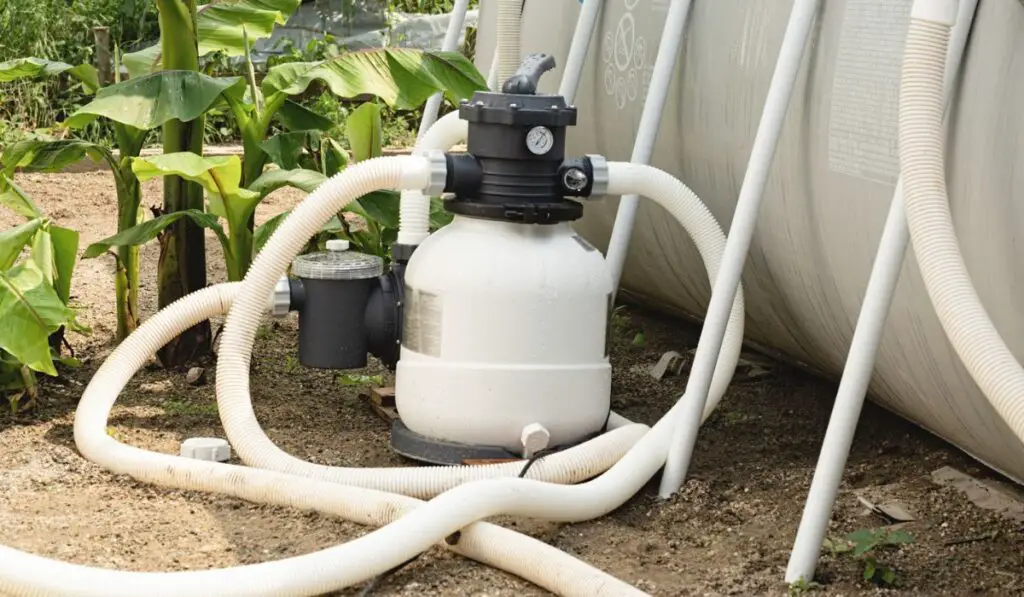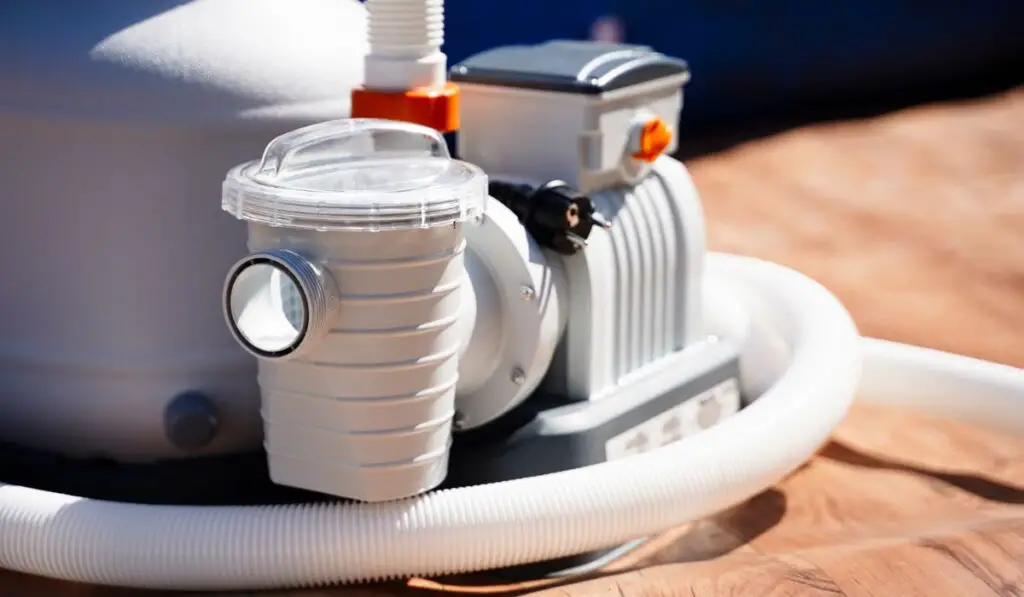Have you noticed dead bugs and algae floating around your pool, making it look all gross and cloudy? If so, it’s a clear indication that the sand in your pool filter has come to the end of its lifespan, and it’s time to replace it. So, how do you change pool filter sand?
To change the sand in your pool filter, start by turning off the pump and draining the tank. Then, remove the multiport valve and the old sand. Now you can wash the tank, fill it halfway with water, add the new sand, and reconnect everything. Backwash and rinse the filter before using it again.
Now that you have a general idea of how to change the sand, let’s get into the details. We’ll take a look at why you need to change your pool filter sand and how to do it properly without causing any damage.
Why Do You Need to Change Pool Filter Sand?

If you observe pool filter sand under a microscope, you’ll notice that it has grains with rough surfaces. The coarse surface enables the sand to trap contaminants as the water flows through it.
As time goes by, the water wears away the pointy surfaces of the sand grains, leaving them smooth and round. This also happens to sand from beaches with strong waves; the grains appear smoother under a microscope when compared to those of sand from a calmer beach.
A similar principle applies to sand in a pool filter, which has water flushing through it frequently in a day.
This smoothing of the coarse surface is due to a process called weathering. When the sand is weathered smooth, it loses all the jagged edges, so it becomes unable to grab and hold contaminants. Consequently, your pool starts looking cloudy as the filter media nears its final days.
Do You Need Tools to Change Your Pool Filter Sand?
Changing the sand in your pool filter can be a complex process, but with a couple of tools on hand, it becomes a painless and fun activity.
Here are some of the tools you’ll need:
- Screwdriver
- Utility knife
- Garden hose
- Duct tape
- Mask
- Portable vacuum or tiny can
- O-ring
- Pool filter sand
- Backwash hose
How to Change Your Pool Filter Sand
Once you’ve got everything you need, we can kick off the process. Here’s how to do it:
Step 1: Turn Off the Pump
First and foremost, you need to turn off the pump and timer if you own one. Alternatively, you can shut off the power to the pump at the circuit breaker.
Step 2: Drain the Tank
Remove the drain cap at the base of your filter tank to drain the water. If you don’t want the water to pour directly onto the ground, swiftly attach a hose over the drain after removing the cap to direct the water elsewhere.
Step 3: Remove the Multiport Valve
Disconnect the pump and waste hoses attached to the multiport valve at the top of your filter. If your valve is hard plumbed with PVC hoses, use the utility knife to cut and remove them.
Next, remove the multiport valve flange clamp that holds the filter in place. Using the screwdriver, unscrew the bolts securing the clamp and gently twist and pull to lift the valve off the pipe.
If your multiport valve has unions, unscrew them from the valve. However, if it doesn’t have unions, you’ll need to use the utility knife again to cut the pipes connected to your filter.
This is also a chance to install unions before reassembling to make future maintenance easier. After the cut, ensure you leave a sufficient portion of pipe exposed so you can add the unions.
Step 5: Remove the Old Sand
Once you’ve disconnected the pipe from the multiport valve, use duct tape to cover the tip of the pipe to prevent sand from entering and clogging the laterals. After taping off the pipe, remove all the sand using the vacuum or plastic can until you can see the laterals at the bottom of the tank.
Step 6: Remove the Lateral Assembly and Pipe
Rotate the ten lateral pipes upwards, then gently pull the lateral assembly and pipe out of the remaining sand. Inspect the laterals for damage, repairing or replacing any that look broken or worn out.
If you notice some laterals are clogged, soak them in a bucket full of cleaning solution for a few hours, then rinse them later on and reinstall them onto the assembly.
Step 7: Wash the Tank
Use the garden hose to wash out the tank thoroughly. Check the drain cap for cracks and replace it with a new one if you spot any. Half-fill the tank with water to provide a cushion and protect the laterals from blocking when you pour in the new sand.
Step 8: Add the New Sand
Keep the taped pipe centered in the tank and carefully pour the fresh sand into the filter until it covers up the laterals completely. Level the sand as you pour it so that it’s evenly distributed for effective filtration and water circulation.
Step 9: Reinsert the Lateral Assembly and Pipe
Insert the lateral assembly and pipe back into the tank, with the ten laterals facing up. Once the lateral assembly is in place, rotate all the laterals to their downward position.
Step 10: Inspect and Replace the O-Ring
Remove the O-ring at the base of the multiport valve and examine it for damage or excessive wear. Considering you change the sand every five years, replacing the O-ring is best, even if it’s still in good shape. O-rings are relatively cheap and won’t put a dent in your wallet.
If you decide not to replace the O-ring, ensure you lubricate it mildly with a silicone-based lubricant.
Step 11: Reconnect the Multiport Control Valve
Remove the tape you initially used to cover the tip of the pipe and carefully return the multiport valve to its original spot on the central pipe. Fasten the valve clamps around the tank and screw them into place.
If you have unions, reconnect them with the pool pump and the return ports. If your filter doesn’t have unions, connect the pipes back together using straight couplers.
Step 12: Backwash the Filter
With the pump still off, turn the valve handle to the backwash setting, then switch on the pump. Run the pump for around two minutes to flush out dirt and debris from the new sand and ensure that your pool water waste is getting out correctly.
Turn off the pool pump when the backwash water becomes clear. Shift the multiport valve to rinse and turn the pump on again. After a minute, you’ll notice clear water in the sight glass.
Step 13: Run the Filter and Enjoy
To finish things off, turn the pool pump off once more and set the valve to filter (its normal operating mode). Now, turn the pump back on and enjoy a relaxing swim in your nice clean pool!
Can You Use Any Sand in Your Pool Filter?

Not just any type of sand will work in the filter. So, if you’re planning on going down to the beach and coming back with a bucket full of sand to pour into your pool filter, think again!
At the very least, regular sand won’t filter your water. What’s highly likely to happen is that it may end up destroying your entire filtration system.
What Are the Different Types of Sand?
Basically, there are three different types of pool filter sand available, with some having a few bonus features other than just the jagged edges that trap contaminants. They are:
Glass Sand
Glass sand (on Amazon) is made from 100% recycled materials making it a great environmentally friendly option for your filter. It also contains sand grains of different sizes, which enable it to minimize channeling in the filter. Channeling is where the water creates a passageway through the sand, allowing it and the contaminants to go through unfiltered.
Zeolite Sand
Cool name, right? Zeolite sand (on Amazon) is made from zeolites, which are volcanic materials found in sedimentary rocks. Besides its awesome name, it also has some extra features.
It has a honeycomb-like structure in the shape of a hexagon to increase the surface area of the sand to almost 100 times more than that of other filter sands. This feature enables it to trap more contaminants.
Silica Sand
Silica sand (on Amazon) is one of the most common filter sands, and it’s made from quartz. Its rough-edged grains make it perfect for trapping contaminants as water flushes through the filter. Silica sand is the only one in this trio with no unique features.
Are There Sand Alternatives?
There are other sand alternatives like poly balls, which are said to be better filter media than sand — but there isn’t enough evidence to back such claims. So, until we see actual proof (not just marketing hype) of the media being used for years, let’s stick to tried and tested filter media such as glass, silica, and zeolite sand.
Other Tips and Tricks
Here are a few tips and tricks for making your job easier when changing the sand in your pool filter:
- Your pool filter contains many tiny yet crucial parts. Always place removable components like the drain cap in a safe, memorable place so you can find them easily during reassembly.
- When removing the multiport valve off the pipe, gently twist and pull. Yanking it breaks the lateral pipes at the bottom of the tank.
- Put on a mask before adding the fresh sand to avoid inhaling dust.
- When adding new sand, ensure you don’t lift the lateral assembly and pipe off the base of the tank. It won’t be easy to push them back down without rotating the laterals up, and upward-facing laterals can prevent proper filtering.
